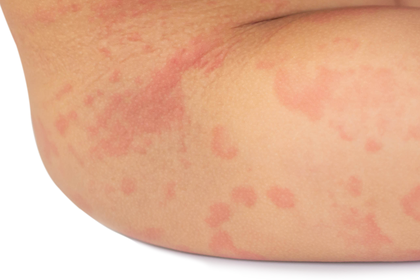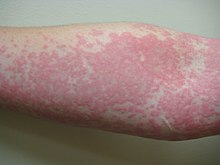What are allergies?
Allergies occur when your immune system overreacts to a foreign substance (known as an allergen), that is normally harmless to most people.
Allergens can include: dust mites, pollen, food, drugs, and insect venoms.
Symptoms of an allergic reaction are very variable and can include:
Sneezing, itching, hives, shortness of breath, runny nose, coughing, and itchy eyes.
/assets/production/practices/11e407216daf86b6b10096904e7bf87133be31aa/images/2607504.png)

Hives
Severity of an allergic reaction
This can range from mild to life-threatening. A life-threatening reaction is known as anaphylaxis.
Symptoms that may require emergency care include:
- Swelling, redness, itching, or hives on the skin
- Itching or swelling of the lips or tongue
- Vomiting, diarrhea, or cramps
- Headache, nasal congestion, or watery eyes.
Symptoms of anaphylaxis
- Shortness of breath, wheezing, coughing, chest pain, or tightness
- Weak pulse, dizziness, or faintness
- Confusion or feeling of impending doom
- Loss of consciousness
The severity of the reaction may increase with repeated exposure.
Different types of allergy
Everyone’s allergies are different. But they can be loosely divided into these 4 groups.
1. Food allergies
Food allergies can trigger swelling, hives, nausea and fatigue. It may take a while for a person to realise that they have a food allergy. If you have a serious reaction after a meal and you’re not sure why, see your GP soon. They may be able to find the cause of your reaction or refer you to a hospital consultant.
2. Seasonal allergies
Hay fever symptoms can mimic those of a cold. They include a blocked and runny nose, and swollen runny eyes. You can manage these symptoms at home using over-the-counter treatments. See your doctor only if your symptoms become unmanageable.
3. Skin allergies
A skin problem may be a sign of an allergy elsewhere. Or may be the direct result of exposure to an allergen – i.e. your skin is allergic to something its exposed to (contact dermatitis).
For example, eating a food you’re allergic to can cause several symptoms. You may experience tingling in your mouth and throat. You may also develop a skin rash.
Contact dermatitis, however, is the result of your skin coming into direct contact with an allergen. This could happen if you touch something you’re allergic to, such as a cleaning product or plant.
Types of skin allergies include:
- Rashes. Areas of skin are irritated, red, or swollen, and can be painful or itchy
- Eczema. Patches of skin become inflamed and can itch and bleed
Contact dermatitis. Red, itchy patches of skin develop almost immediately after contact with an allergen
- Urticaria (hives). Red, itchy, and raised welts of various sizes and shapes develop on the surface of the skin
- Swollen eyes. Eyes may be watery, itchy or puffy
- Itching. There’s irritation or inflammation in the skin
- Burning. Skin inflammation leads to discomfort and stinging sensations on the skin.
4. Severe allergies
Severe allergies can cause anaphylaxis. This is a life-threatening emergency that can lead to breathing difficulties, light-headedness, loss of consciousness, and even cardiac arrest. If you’re experiencing these symptoms after coming in contact with a possible allergen, seek medical help immediately.
Summary
We have described what are allergies. We hope it has been helpful.


